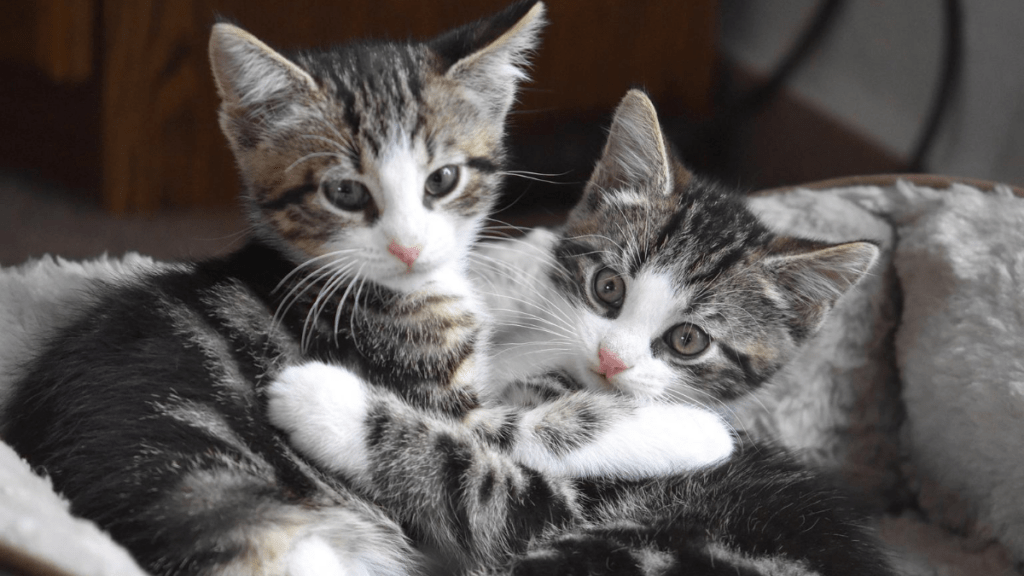Two of the most common (and most serious) conditions that affect cats are the Feline Leukemia Virus (FeLV) and the Feline Immunodeficiency Virus (FIV). While it’s possible for a cat who has been infected with either virus to live a long, healthy life, cat owners need to be aware of these two viral conditions and their highly contagious natures. Today we’d like to fill you in on the basics of FeLV and FIV and how they affect the feline population. This is an especially important read if you have one or more cats already living in your home, and you are considering adding another cat to your family.
FeLV and FIV are viruses that suppress an animal’s immune system. When a cat becomes infected, the virus will travel to the lymph nodes and/or bone marrow. The virus then replicates. It is possible for a cat’s immune system to fight off the virus. If the immune system is not strong enough to do so, the immune system will become compromised and the cat will become more susceptible to illness caused by bacteria, other viruses, and fungi.
Both FeLV and FIV may live in a cat’s body for years before causing any life-threatening conditions. These viral infections are both common and serious, but with proper health care and a timely diagnosis, infected cats may still experience a high quality of life.
FeLV and FIV are viruses that suppress an animal’s immune system. When a cat becomes infected, the virus will travel to the lymph nodes and/or bone marrow. The virus then replicates. It is possible for a cat’s immune system to fight off the virus. If the immune system is not strong enough to do so, the immune system will become compromised and the cat will become more susceptible to illness caused by bacteria, other viruses, and fungi.
Both FeLV and FIV may live in a cat’s body for years before causing any life-threatening conditions. These viral infections are both common and serious, but with proper health care and a timely diagnosis, infected cats may still experience a high quality of life.
Transmission
The Feline Leukemia Virus is most commonly spread through saliva. Infected cats may also shed the virus in blood, urine, feces, nasal secretions, and milk. A cat may be infected by another cat through mutual grooming, sharing food/water bowls, using the same litter box, or by fighting. Infected mothers can also spread the virus to their fetuses during pregnancy or to their babies when nursing.
The Feline Immunodeficiency Virus is usually spread when an infected cat inflicts a bite wound on an uninfected cat.
Cats cannot infect humans with FeLV or FIV.
The Feline Immunodeficiency Virus is usually spread when an infected cat inflicts a bite wound on an uninfected cat.
Cats cannot infect humans with FeLV or FIV.
Consequences of FeLV and FIV
When a cat’s immune system becomes compromised from FeLV, the most common condition that eventually results is cancer. Because the virus spreads to lymph nodes and/or bone marrow, the types of cancers that it can cause include lymphoma (cancer of the lymphatic tissues) and leukemia (cancer of the bone marrow). Anemia (a deficiency of red blood cells) is another common condition caused by FeLV. The compromised immune system of an infected cat can also cause the cat to suffer infection from environmental bacteria, viruses and fungi that would otherwise be considered harmless. The Feline Leukemia Virus often works slowly within an animal’s bloodstream and tissues, and it can take months or years for these conditions to present.
FIV most commonly manifests as inflammation of the mouth or eye, or as cancer. Cats with FIV will often repeatedly experience illness due to a compromised immune system.
It is important to remember that the diagnosis of FeLV or FIV does not mean that a cat will have a poor quality of life. Supportive care and newer treatment approaches often help a cat achieve several more healthy and happy years of life.
FIV most commonly manifests as inflammation of the mouth or eye, or as cancer. Cats with FIV will often repeatedly experience illness due to a compromised immune system.
It is important to remember that the diagnosis of FeLV or FIV does not mean that a cat will have a poor quality of life. Supportive care and newer treatment approaches often help a cat achieve several more healthy and happy years of life.
Testing
Routine testing of outdoor cats is essential for early diagnosis and to prevent the spread of either virus.
In order to diagnose a FeLV/FIV infection, a test must be performed that detects the presence of either virus in a cat’s blood. At House Paws, we use a test called a SNAP test. This type of test requires a small blood sample and produces results within 15 minutes.
Some cats who test positive for FeLV or FIV develop a strong immune system response, allowing their bodies to self-control the infection and prevent the development of conditions like cancer. In other cases, the virus may be present in the bloodstream at the time of the test and then may move into the bone marrow or lymphatic tissue soon afterward. It may be recommended to retest a cat again after an initial “positive” test result, so as to determine if the immune system has developed a defense against the virus, or if the virus is beginning to cause more serious health consequences that will need to be managed. Your veterinarian will be able to discuss testing and the recommended protocol, as well as next steps after receiving test results.
In order to diagnose a FeLV/FIV infection, a test must be performed that detects the presence of either virus in a cat’s blood. At House Paws, we use a test called a SNAP test. This type of test requires a small blood sample and produces results within 15 minutes.
Some cats who test positive for FeLV or FIV develop a strong immune system response, allowing their bodies to self-control the infection and prevent the development of conditions like cancer. In other cases, the virus may be present in the bloodstream at the time of the test and then may move into the bone marrow or lymphatic tissue soon afterward. It may be recommended to retest a cat again after an initial “positive” test result, so as to determine if the immune system has developed a defense against the virus, or if the virus is beginning to cause more serious health consequences that will need to be managed. Your veterinarian will be able to discuss testing and the recommended protocol, as well as next steps after receiving test results.
Prevention
FeLV infections may be prevented through vaccination. We always recommend testing for FeLV infection before vaccinating. There is currently no effective vaccination to prevent FIV infection.
Aside from vaccination, FeLV and FIV may be prevented by keeping your cat indoors and away from other cats who may have higher risks of exposure.
Aside from vaccination, FeLV and FIV may be prevented by keeping your cat indoors and away from other cats who may have higher risks of exposure.
Because of the highly contagious nature of FeLV and FIV infections, it is highly recommended that any cat being brought into a household be tested, especially if other cats already reside in the same household. If a household already contains an FeLV/FIV-positive cat, no new cats should be brought into the same home unless they also are FeLV/FIV-positive, to prevent any viral spread. Any cats that are new to a multi-cat home should be kept separate from the other household cats until it is confirmed through testing that the new cat has not been infected with FeLV or FIV. This can sometimes take 4-6 weeks. If you are looking to adopt a cat and…
Keep the new cat isolated from any resident cat(s) that have FeLV or FIV for at least 4-6 weeks. During this time, it is recommended that your veterinarian tests the new cat. If the new cat is FeLV/FIV-negative, he will need to be vaccinated against FeLV and stay up-to-date on that yearly vaccine in order to safely interact with your other cat(s). If your new cat is also positive for the same virus, you can safely allow them to interact with each other and no vaccines may be necessary. Keep in mind that because there is no effective FIV vaccine, if your resident cat has FIV and your new cat does NOT, any interaction between the two will put your new cat at risk of contracting FIV.
Keep your new cat isolated from any resident cats until you have tested your new cat for FeLV and FIV. Once you have received test results, your veterinarian will be able to work with you on a future plan for intermingling your new cat with your resident cat(s).
Test your current resident cats as well as the cat you are planning to adopt, and make decisions based on the results of those test.
We always recommend testing your new cat for FeLV and FIV. Having these test results will assist you in making health care decisions for your new cat upon adoption, and in the future.






